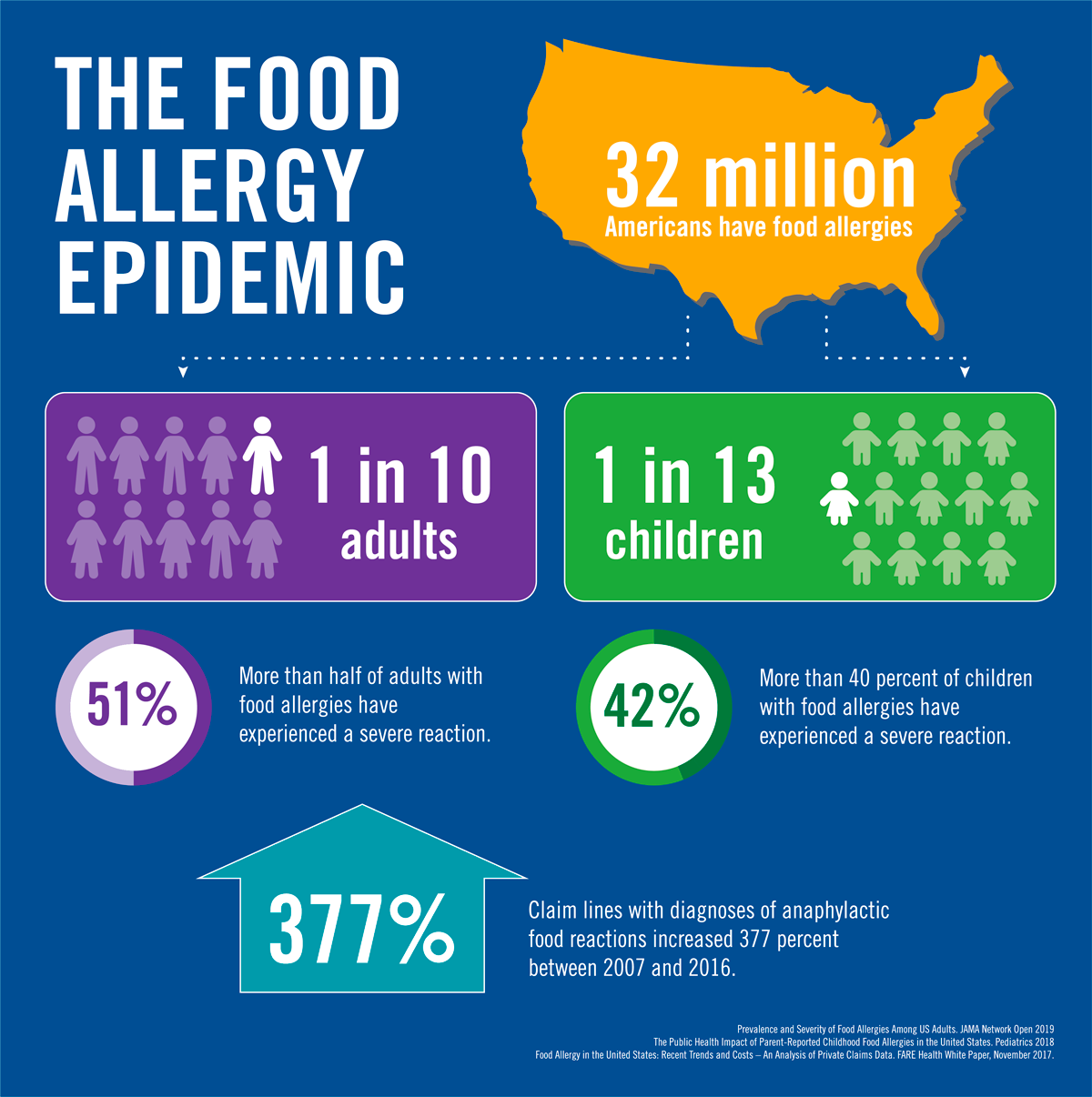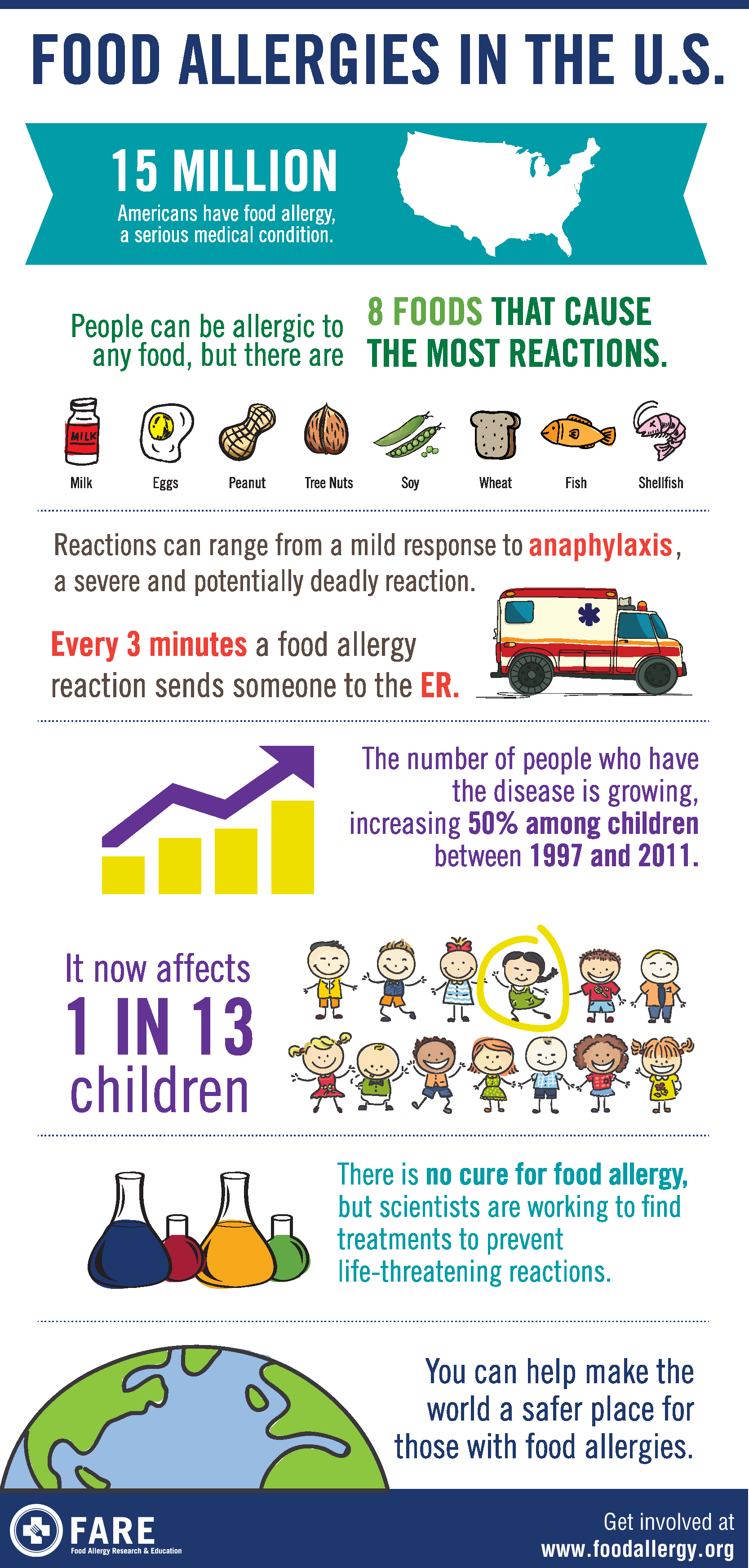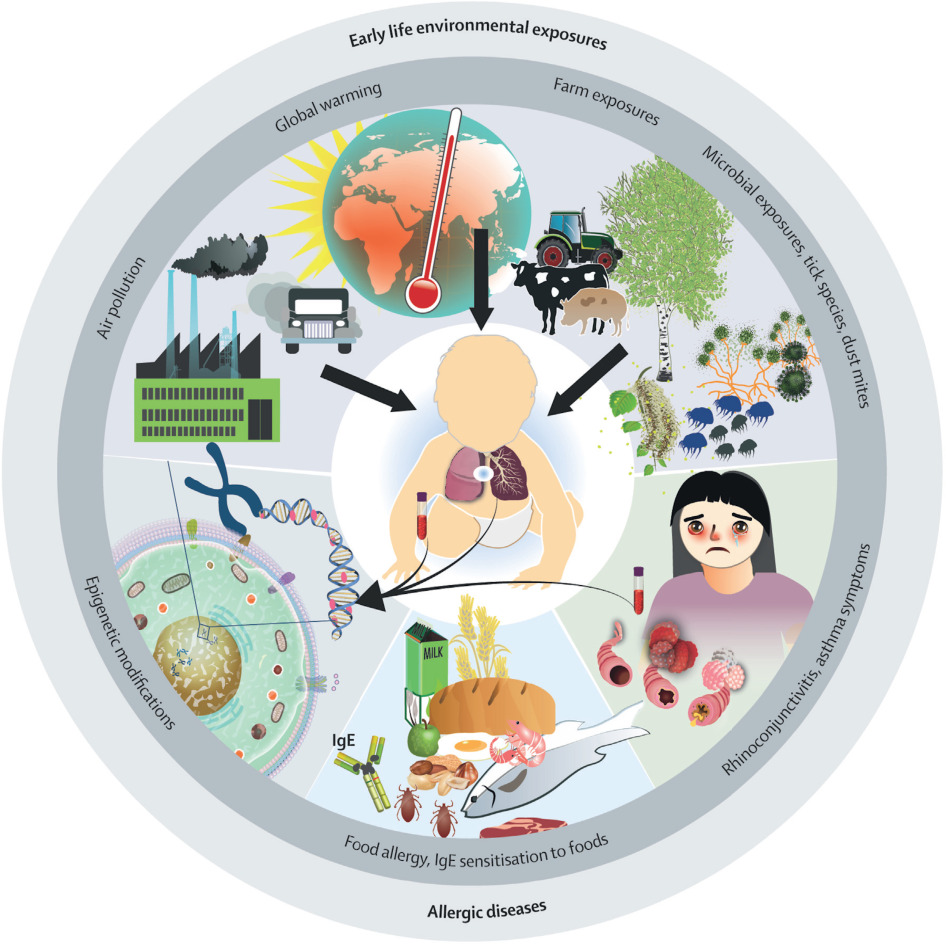
Key facts
- A food allergy is an immune response to a food that the body incorrectly identifies as being dangerous.
- Food allergies can range from mild to severe and in some cases can be life-threatening.
- Children need to avoid eating foods that they are allergic to.
- As children get older, they often outgrow their food allergies.
- If your child has a food allergy, you should work with their doctor to create an ASCIA action plan. This plan will guide you in the event your child experiences an allergic reaction, including a severe reaction (anaphylaxis).
What are food allergies?
A food allergy is when your body’s immune system reacts to a food that is normally harmless. When this happens, your immune system responds to this food as if it were dangerous and the result is known as an allergic reaction.
Food allergies affect around 1 in 10 one-year-old children in Australia. Some allergic reactions are mild, but some can be severe, and even life–threatening. If the reaction affects your breathing or your heart, this is called anaphylaxis.
The most common food allergies in children are:
- nut allergies
- dairy allergies
- wheat allergies
- soy allergies
- egg allergies
- seafood allergies
- seed allergies
Remember that food allergies can be caused by anything that is eaten, including things that you might not think of as food, such as herbal medicines or spices.
What are the differences between food allergies and intolerance?
A food intolerance is different to a food allergy since it does not involve the body’s immune system. Food allergies always involve a reaction of the immune system, but food intolerances have several possible causes, such as an inability to digest or absorb a particular type of food, or a chemical sensitivity to an ingredient. Symptoms of food intolerances and food allergies can be similar, but food intolerances only rarely cause life-threatening symptoms.
Food intolerances are diagnosed with a temporary elimination diet, under the supervision of a dietitian or doctor, and will not show a positive result with an allergy test.
How do I know if my child has a food allergy or intolerance?
If your child experiences symptoms of food allergies, ask their doctor whether a food allergy or intolerance may be the cause.
Symptoms of mild-to-moderate food allergies in children include:
- swelling of their face, lips or eyes
- bumps (hives) on their skin
- stomach pain
- vomiting
Signs of a severe food allergy (anaphylaxis) include:
- difficulty breathing or noisy breathing
- swollen tongue
- swelling or tightness in the throat
- difficulty talking or hoarse voice
- wheezing or coughing
- dizziness
- collapsing
Young children may become pale and floppy.
It can sometimes be difficult to know if your baby or young child is experiencing a food allergy. They may have symptoms such as:
- eczema
- diarrhoea that lasts more than a few days (chronic diarrhoea)
- reflux
- a slower than expected rate of weight gain (failure to thrive)
When should my child see a doctor about food allergies?
If you are concerned that your child may be experiencing food allergies or has any food allergy symptom as described above, see their doctor. Your child may be referred to an allergist, immunologist or paediatrician.
How are food allergies diagnosed?
If you think your child may have a food allergy, their doctor may recommend some tests. These could include:
- Skin-prick testing — this tests for allergies by placing tiny amounts of the food being tested on your child’s arm, and gently pricking it into the skin. The test is positive if a small itchy lump appears on the arm within 20 minutes.
- Blood tests (allergen-specific IgE) — check if your child’s immune system has a response to a particular type of food as a sign of allergy. This is useful if your child is taking eczema or allergy medicines, since a skin-prick test would not be reliable.
How are allergic responses to food treated?
Food allergies are best treated by determining what foods your child is allergic to and being careful to avoid them. Even if you are very careful, there is always a risk that they could eat a food that they are allergic to by mistake. If they are at risk of severe food allergy (anaphylaxis), you should work with their doctor to create a personal ASCIA action plan for anaphylaxis.
What is an ASCIA action plan?
An ASCIA action plan tells you what to do if your child has an allergic reaction. This will normally include using an adrenaline autoinjector, which should be with your child all the time, including at day care, school or when in the care of others.
Avoiding foods that trigger an allergic reaction
Once you know what foods your child is allergic to, they must avoid eating them. All carers (including school and day-care staff, and family members) should read and understand the allergy information on food labels. People who prepare food for your child must be informed about the foods that contain the ingredient to which they are allergic.
Adrenaline autoinjectors
Adrenaline autoinjectors are used to treat the symptoms of a severe allergic reaction (anaphylaxis). The medicine in an autoinjector is called adrenaline. Adrenaline works very quickly to reduce the signs of an allergic reaction such as throat swelling and restricted airways.
There are 2 different brands of adrenaline autoinjectors available in Australia; and . Both brands have one autoinjector for adults and another for children who weigh between 15kg and 30kg, which contains a lower dose of adrenaline. Training devices are available to help you, your child and other caregivers learn how to use an adrenaline autoinjector.
If you need to use one in an emergency but are not sure how, instructions are printed on the packaging of the device, as well as in every ASCIA action plan.
Treating other symptoms of food allergies
Food allergies can be related to other conditions such as eczema and asthma. While avoiding foods that trigger allergy is the most important method of preventing allergic reactions, other related conditions, including eczema and asthma, can be improved with specific treatments. You can discuss any symptoms that you think may be connected to your child’s food allergies with their doctor. They can develop a plan to manage your child’s symptoms.
Other treatments
Immunotherapy can be used to “switch off” allergies by desensitising a person to the things to which they are allergic, although it is not yet known if immunotherapy can help people with food allergies. Ask your child’s doctor if immunotherapy could be useful in managing their allergies.
Can allergic responses to food be prevented?
Children who have known allergies
The best way to prevent your child with food allergies from experiencing an allergic reaction is to help them avoid the foods that they are allergic to. If someone else prepares their food — for example, in another person’s home, at a restaurant or at a school canteen — you should make sure that they know about your child’s food allergy and how they can help your child avoid eating foods that they are allergic to.
Planning can help make sure that suitable food will be available when they need it. You can order a special meal on an airplane, call a restaurant before you visit to let them know your child’s needs or even bring food from home if you are unsure. Food allergies are common in Australia, and it is not unusual for venues to receive such requests.
Your child should have an ASCIA action plan. You should also work with their school on how they can help your child avoid foods that they are allergic to, and what the staff should do in case of an allergic reaction, including knowing where your child’s adrenaline autoinjectors are kept.
Baby weaning and allergy prevention
Introduce common allergy-causing foods by 12 months of age in an age-appropriate form, such as well-cooked egg and smooth peanut butter. Introducing babies to foods that commonly cause allergies before their first birthday can reduce their risk of developing severe food allergies if they already have severe eczema or egg allergy. You should introduce new foods slowly: only introduce one new food at a time. This way, if your baby has a reaction, you will know which new food they are reacting to.
If your baby has an allergic reaction to food, stop giving that food and see their doctor. Once a new food has been introduced, you should try to include it in your child’s meals at least twice a week. Trying a new food but not eating it regularly can cause a food allergy to develop.
Can my child outgrow food allergies?
Food allergies can be outgrown. This means that as your child grows up, they may stop being allergic to a particular food. It is more common to outgrow an allergy to cow’s milk, soy, wheat or egg. It is less common to outgrow allergies to peanuts, tree nuts, sesame seeds or seafood — these allergies will be lifelong for 3 out of 4 children.





